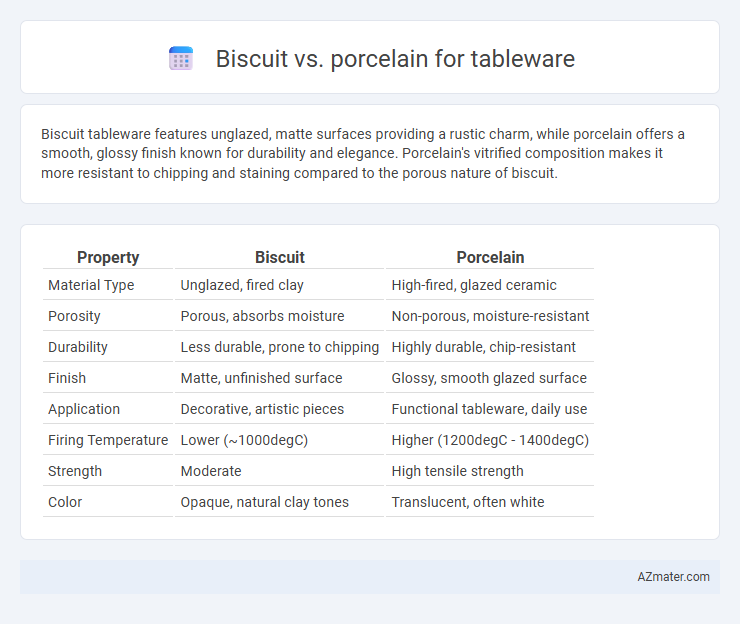Biscuit tableware features unglazed, matte surfaces providing a rustic charm, while porcelain offers a smooth, glossy finish known for durability and elegance. Porcelain's vitrified composition makes it more resistant to chipping and staining compared to the porous nature of biscuit.
Table of Comparison
| Property | Biscuit | Porcelain |
|---|---|---|
| Material Type | Unglazed, fired clay | High-fired, glazed ceramic |
| Porosity | Porous, absorbs moisture | Non-porous, moisture-resistant |
| Durability | Less durable, prone to chipping | Highly durable, chip-resistant |
| Finish | Matte, unfinished surface | Glossy, smooth glazed surface |
| Application | Decorative, artistic pieces | Functional tableware, daily use |
| Firing Temperature | Lower (~1000degC) | Higher (1200degC - 1400degC) |
| Strength | Moderate | High tensile strength |
| Color | Opaque, natural clay tones | Translucent, often white |
Understanding Biscuit and Porcelain: Key Differences
Biscuit tableware features unglazed, matte surfaces that emphasize texture and are porous, making them more prone to staining compared to porcelain. Porcelain tableware is fired at higher temperatures, resulting in a vitrified, non-porous surface with a glossy finish that enhances durability and resistance to moisture. The key differences lie in biscuit's raw, porous character versus porcelain's smooth, glass-like quality, influencing their practical use and aesthetic appeal in tableware.
Historical Evolution of Biscuit and Porcelain Tableware
Biscuit and porcelain tableware have distinct historical developments tied to advances in ceramic technology. Biscuit porcelain, characterized by its unglazed, matte finish, gained popularity in 18th-century Europe, especially in France and England, for its sculptural qualities and detailed artistic expression. Porcelain, originating from China during the Tang Dynasty and perfected in the Ming and Qing Dynasties, introduced a durable, translucent, and glazed surface that revolutionized tableware aesthetics and functionality in the global trade market.
Material Composition and Production Techniques
Biscuit tableware is made from unglazed porcelain fired at high temperatures, resulting in a matte, porous surface that highlights fine detail and texture. Porcelain tableware undergoes a glazing process after firing, creating a smooth, glossy finish that enhances durability and resistance to stains. The production of biscuit involves precise control of kiln temperature to maintain its characteristic matte appearance, while porcelain requires glazing and a second firing to achieve its signature sheen and waterproof qualities.
Appearance and Texture: Matte vs Glossy Finishes
Biscuit porcelain features a matte, unglazed finish that offers a soft, velvety texture providing a natural and understated elegance, while traditional glazed porcelain tableware exhibits a glossy, smooth surface that enhances color vibrancy and reflects light for a polished look. The porous nature of biscuit porcelain contributes to its tactile warmth and subtle visual depth, contrasting with the sleek and shiny appearance of glazed porcelain. Matte finishes on biscuit pieces emphasize artisanal craftsmanship and simplicity, whereas glossy finishes on porcelain are valued for their durability and ease of cleaning in everyday use.
Durability and Strength Comparison
Biscuit porcelain, known for its unglazed matte finish, offers moderate strength but is more prone to chipping due to its porous surface. In contrast, glazed porcelain tableware boasts superior durability with a dense, non-porous layer that enhances resistance to scratches and thermal shock. For everyday use, glazed porcelain provides a stronger and longer-lasting option compared to the delicate nature of biscuit porcelain.
Suitability for Everyday Use vs Special Occasions
Biscuit porcelain offers a matte, unglazed finish that is durable and resistant to chipping, making it suitable for everyday use where practicality and ease of cleaning are essential. Porcelain tableware, known for its glossy, glazed surface and delicate appearance, is often reserved for special occasions due to its refined look and potential fragility. Choosing biscuit porcelain maximizes functionality in daily settings, while traditional glazed porcelain enhances elegance and formality during celebrations or formal dining.
Cleaning and Maintenance Considerations
Biscuit porcelain, known for its unglazed, matte surface, requires gentle cleaning with soft brushes or cloths to avoid abrasion, as harsh detergents can damage its porous texture. Porcelain tableware with a glazed finish offers easier maintenance, allowing for dishwasher use and resistance to stains and moisture. Proper care of both materials ensures longevity, but porcelain's glazing provides a more durable and stain-resistant surface compared to the delicate nature of biscuit porcelain.
Cost and Value: Which is More Economical?
Biscuit porcelain, unglazed and less processed, typically incurs lower manufacturing costs, making it more affordable than fully glazed porcelain tableware. However, glazed porcelain offers superior durability and stain resistance, translating to longer-lasting value despite its higher upfront price. Choosing biscuit porcelain suits budget-conscious buyers seeking aesthetic matte finishes, while glazed porcelain provides greater economic efficiency over time due to enhanced strength and ease of maintenance.
Popular Uses and Styles in Modern Table Settings
Biscuit porcelain, known for its unglazed, matte finish, is favored in decorative tableware and artistic pieces, adding a rustic and contemporary touch to modern settings. Traditional glazed porcelain offers durability and a glossy surface, making it ideal for everyday use and formal dining with intricate patterns and vibrant colors. Both materials complement minimalist and eclectic styles, with biscuit porcelain enhancing texture and porcelain providing elegance in table presentation.
Choosing the Right Tableware: Biscuit or Porcelain?
Biscuit and porcelain tableware vary in durability, appearance, and texture, impacting their suitability for different uses. Biscuit ware, known for its unglazed, matte finish, offers a rustic aesthetic and is more prone to staining but ideal for decorative or low-use settings. Porcelain, with its glazed, smooth surface, provides enhanced durability, resistance to chipping and staining, and is better suited for everyday use and formal dining experiences.

Infographic: Biscuit vs Porcelain for Tableware
 azmater.com
azmater.com